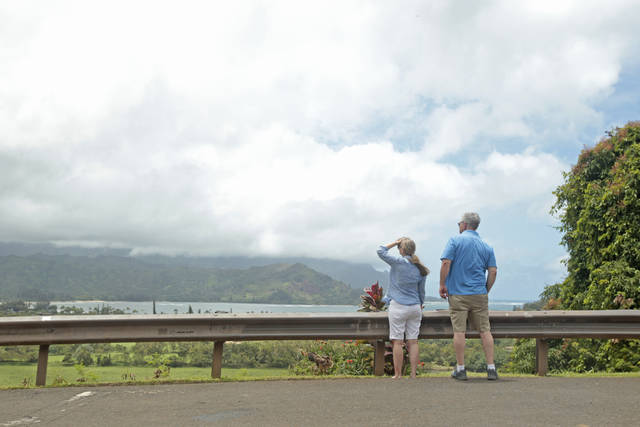Plan to cap Haena park day hikers at 900 advances

JAMM AQUINO/JAQUINO@STARADVERTISER.COM
The BLNR will restrict Kauai park users to 900 daily. A man and woman look out onto Hanalei Bay from Kuhio Highway on Monday, April 23, 2018 in Hanalei, Kauai.
The state is moving forward on plans to limit the number of daily visitors to the popular Haena State Park on Kauai’s north shore.
The state Board of Land and Natural Resources on Friday reviewed a master plan that would only allow 900 — rather than 2,000 — visitors per day at the popular park, which is the gateway to the Napali Coast State Wilderness Park and popular Kalalau Trail. The board recommended that Gov. David Ige approve the final environmental impact statement Opens in a new tab prepared by PBR Hawaii, and give the BLNR leader authority to approve the final master plan, which has been in the works for 20 years.
It is the state park division’s first attempt to reduce daily patronage at a park. Haena State Park is visited by hundreds of thousands of people each year.
“The most significant proposal in the draft master plan is to initially limit the number of park visitors,” said DLNR Division of State Parks Assistant Administrator Alan Carpenter in a news release. “This is a major paradigm shift in Hawaii State Parks management. We may adjust that ceiling in time based on overall negative or positive impacts.”
The initial number includes day hikers heading on to the Kalalau Trail but does not include permitted overnight campers, hunters with valid permits, local residents, cemetery caretakers, volunteers attending various events or kupuna or cultural practitioners with cultural or ancestral ties to the area.
The number of visitors could be managed by an online system, according to the plan, that can distribute real-time information on park access, entry ticket availability, special events and weather conditions.
Don't miss out on what's happening!
Stay in touch with breaking news, as it happens, conveniently in your email inbox. It's FREE!
The plans also call for the overflow parking lot farther away from the highway to become the main parking lot offering 100 stalls, with a new entry turnaround, shuttle stop and pedestrian boardwalk connecting the lot to Kee Beach. The main parking lot would also be separated into a fee-paying lot and non-fee-paying lot.
New structures include a “Welcome Hale” near the improved main parking lot with interpretive and informational signs, and two small, comfort stations to reduce wastewater flows at the existing Kee comfort station.
The plan also calls for re-establishing the area makai of the Kalalau trailhead, encompassing Ka Ulu a Paoa Heiau and former Allerton property, as a “Hula Complex.”
In addition, the plan recommends that the historic state highway that runs through the park be transferred from the state Department of Transportation to the state Division of State Parks so it can be closed to general through traffic.
Carpenter said the state will work to establish a Cultural Advisory Committee to advise it on the design and implementation of park improvements and management.
“We think these are important steps to be sure that all management actions we take at Haena include thorough consultation with primary stakeholders — the people who live at Haena,” he said.
Haena State Park and Napali Coast State Wilderness parks currently remain closed for months-long clearing and repairs following severe damage from mid-April floods.
BLNR Chairwoman Suzanne Case said the importance of the master plan has been elevated due to impacts of recent flooding on Kauai’s north shore, and that its implementation could be facilitated using disaster mitigation funds.






